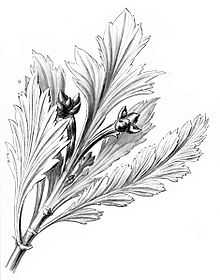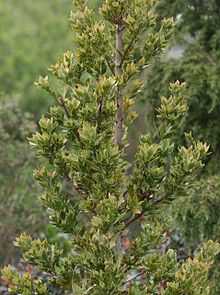Phyllocladus aspleniifolius
| Phyllocladus aspleniifolius | |
|---|---|
 | |
| Conservation status | |
| Scientific classification | |
| Kingdom: | Plantae |
| Division: | Pinophyta |
| Class: | Pinopsida |
| Order: | Pinales |
| Family: | Podocarpaceae |
| Genus: | Phyllocladus |
| Species: | P. aspleniifolius |
| Binomial name | |
| Phyllocladus aspleniifolius (Labill.) Hook.f. | |

Phyllocladus aspleniifolius (Celery-top pine) is an endemic gymnosperm of Tasmania, Australia. It is found in rainforest as a dominant, in eucalypt forest as an understorey species, and occurs occasionally as a shrub in alpine vegetation. It is confined to areas of high rainfall and low fire frequency.
It is a medium-sized evergreen coniferous tree, growing to 20 m tall (rarely 30 m, and often shrubby at high altitudes). The leaves are minute, brown and scale-like, less than 1 mm long, and sparsely produced; what looks like leaves on the plant are actually modified stems called phylloclades. These phylloclades are diamond-shaped, 2–5 cm long, 1–2 cm broad and 0.5 mm thick, light yellowish green above, strongly glaucous blue-green below with stomatal wax, and with a bluntly toothed or lobed margin. The phylloclades are borne spirally on green stems; each phylloclade has a scale leaf at its base. The cones are highly modified, with several scales, each scale berry-like with a red and white aril and a single seed.
The scientific name is commonly spelled asplenifolius, but under the ICBN, this is an orthographic error to be corrected. It derives from the superficial similarity of the phylloclades to the fronds of some species of Asplenium ferns.
Uses
The wood of this species is highly prized by fine furniture makers and wooden boat builders. The species continues to be harvested in Tasmania through clearfell logging operations.
References
- Conifer Specialist Group (1998). Phyllocladus aspleniifolius. 2006. IUCN Red List of Threatened Species. IUCN 2006. www.iucnredlist.org. Retrieved on 10 May 2006.
- Gymnosperm Database: Phyllocladus aspleniifolius
- Photos of foliage, foliage and cones, cones
